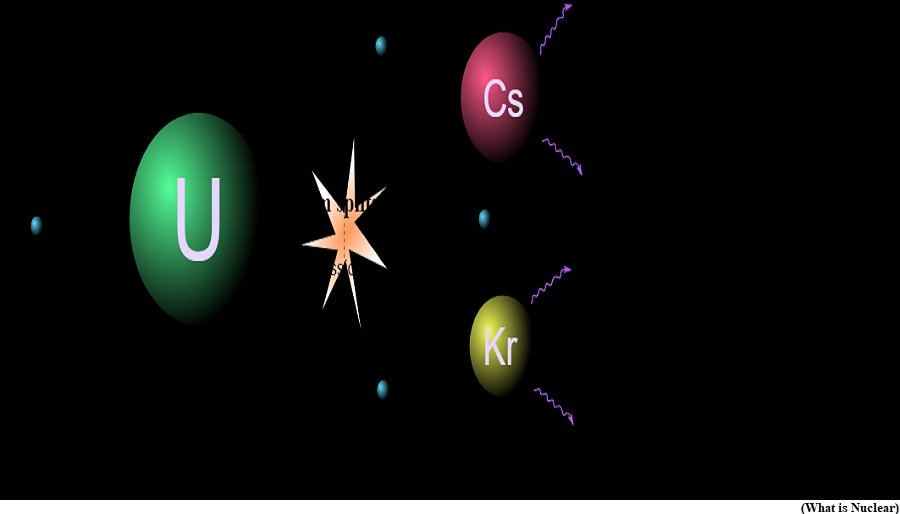How is nuclear waste generated? (GS Paper 3, Science and Technology)

Why in news?
- Recently, India loaded the core of its long-delayed Prototype Fast Breeder Reactor (PFBR) vessel, bringing the country to the cusp of stage II powered by uranium and plutonium of its three-stage nuclear programme.
- By stage III, India hopes to be able to use its vast reserves of thorium to produce nuclear power and gain some energy independence. But the large-scale use of nuclear power is accompanied by a difficult problem: waste management.
What is nuclear waste?
- In a fission reactor, neutrons bombard the nuclei of atoms of certain elements. When one such nucleus absorbs a neutron, it destabilises and breaks up, yielding some energy and the nuclei of different elements.
- For example, when the uranium-235 (U-235) nucleus absorbs a neutron, it can fission to barium-144, krypton-89, and three neutrons. If the ‘debris’ (barium-144 and krypton-89) constitute elements that can’t undergo fission, they become nuclear waste.
- Nuclear waste is highly radioactive and needs to be stored in facilities reinforced to prevent leakage and/or contamination of the local environment.
How to handle nuclear waste?
- Handling the spent fuel is the main challenge, it is hot and radioactive, and needs to be kept underwater for up to a few decades. Once it has cooled, it can be transferred to dry casks for longer-term storage.
- All countries with long-standing nuclear power programmes have accumulated a considerable inventory of spent fuel. For example, the U.S. had 69,682 tonnes (as of 2015), Canada 54,000 tonnes (2016), and Russia 21,362 tonnes (2014).
- Nuclear power plants also have liquid waste treatment facilities. Small quantities of aqueous wastes containing short-lived radionuclides may be discharged into the environment.
- Japan is currently discharging, after treatment, such water from the Fukushima nuclear power plant into the Pacific Ocean. Other such waste, depending on their hazard, can be evaporated or “chemically precipitated” to yield a sludge to be treated and stored, “absorbed on solid matrices” or incinerated.
- Liquid high-level waste contains “almost all of the fission products produced in the fuel”. It is vitrified to form a storable glass.
How is nuclear waste dealt with?
- Once spent fuel has been cooled in the spent-fuel pool for at least a year, it can be moved to dry-cask storage. It is placed inside large steel cylinders and surrounded by an inert gas. The cylinders are sealed shut and placed inside larger steel or concrete chambers.
- Some experts have also rooted for geological disposal: the waste is sealed in “special containers”, and buried underground in granite or clay. The upside here is long-term storage away from human activity, although some studies have pointed to the risk of radioactive material becoming exposed to humans if the containers are disturbed, such as by nearby digging activity.
- Reprocessing is another way to deal with the spent fuel. Here, the material is chemically treated to separate fissile material left behind from the non-fissile material. Because spent fuel is so hazardous, reprocessing facilities need specialised protections and personnel of their own. Such facilities present the advantage of higher fuel efficiency but are also expensive.
- Reprocessing also yields weapons-usable (different from weapons-grade) plutonium. The IAEA has specified eight kilograms of plutonium in which plutonium-239 accounts for more than 95% to be the threshold for “safeguards significance”. It tightly regulates the setting up and operation of these facilities as a result.
How does India handle nuclear waste?
- According to a 2015 report of the International Panel on Fissile Materials (IPFM), India has reprocessing plants in Trombay, Tarapur, and Kalpakkam.
- The Trombay facility reprocesses 50 tonnes of heavy metal per year (tHM/y) as spent fuel from two research reactors to produce plutonium for stage II reactors as well as nuclear weapons.
- Of the two in Tarapur, one is used to reprocess 100 tHM/y of fuel from some pressurised heavy water reactors (stage I) and the other, commissioned in 2011, has a capacity of 100 tHM/y. The third facility in Kalpakkam processes 100 tHM/y.
- The wastes generated at the nuclear power stations during the operation are of low and intermediate activity level and are managed at the site itself.
- They are treated and stored in on-site facilities, that “such facilities are located at all nuclear power stations”, and that the surrounding area “is monitored for radioactivity”.
- The IPFM report also said the PFBR’s delays suggested the Tarapur and Kalpakkam facilities “must have operated quite poorly, with a combined average capacity factor of around 15%”.


